Huang Huan-chang (黃煥彰) was once nearly run over by an angry business owner whom he reported on for polluting a fish farm. The long-time environmental activist is used to threats, and vividly recounts the time a factory boss trapped him inside a complex, and he had to use a hammer to smash a lock and escape.
Although Huang sees himself as a crow, tirelessly cawing at the government and industry for the past 26 years to protect the environment, his opponents call him a ghost. He earned the moniker in the early 2010s after he revealed that Taiwan Alkali Industrial Corp (TAIC, 台鹼公司) was polluting tilapia fish farms in Tainan with dioxin and mercury.
“From 2010 to 2015, I was constantly there,” Huang says. “I recorded them testing the soil. I followed them when they investigated runoff to fisheries. I shadowed their every move, and they began saying, ‘we’ve been possessed by a ghost!’ The most vital part of environmental activism is being on site. I’ve been closely following some of these cases for 20 years, and if government officials want to argue with me, I know exactly how to rebuke them.”
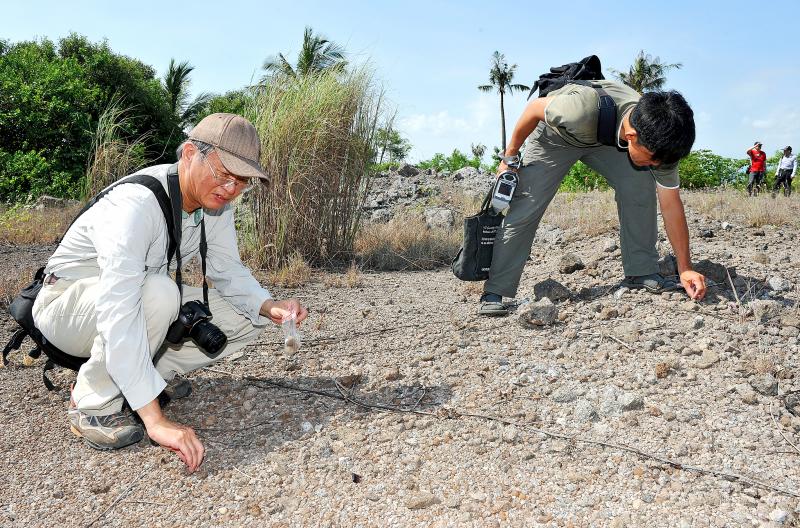
Photo: Chien Jung-fong, Taipei Times
Huang won the Lifetime Environmental Protection Award earlier this month at the Environmental Non-Governmental Organizations Convention in Taipei, earning him a three-minute audience with President Tsai Ing-wen (蔡英文), where he discussed lax government policy and ongoing issues regarding industrial waste disposal.
Although Huang has drawn public attention to land use issues, he laments that the overall situation hasn’t improved in the last 26 years because the worst offenders have gotten sneakier in their dumping practices. Instead of piling up mounds of waste as they did in the old days, they now use loopholes in the law to get away with burying it — often without proper treatment — on farmland and in fisheries.
“It’s a serious threat to food safety, and we’re stealing our descendants’ future,” Huang says.
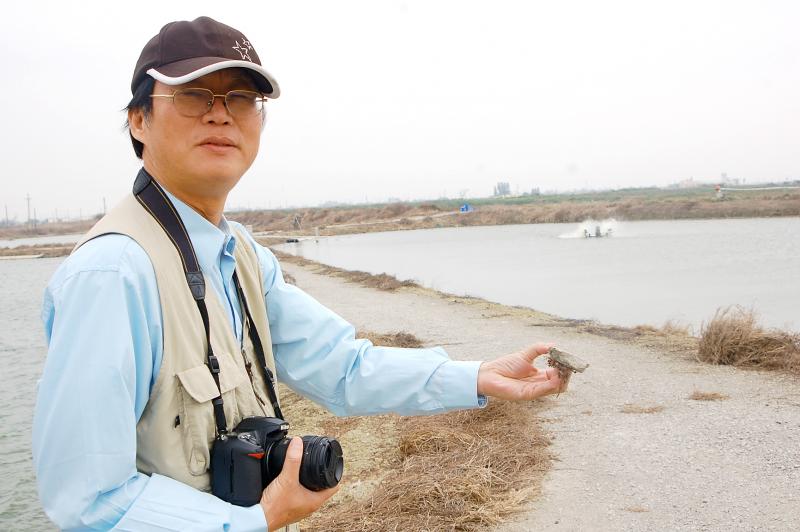
Photo: Tsai Wen-chu, Taipei Times
COLORFUL RIVERS
Huang, who turns 60 this year, has dedicated nearly half of his life to environmental activism. His early passion in photography brought him in the mid-1990s to the Erjen River (二仁溪) on the Tainan-Kaohsiung border, where he saw a 3km stretch of dead fish in waters heavily polluted by years of dumping electronic waste.
“I cried for 20 minutes when I saw that scene. I decided that I had to do something about this. I gave up my goals of furthering my career, abandoned my research plans and delved into environmental activism,” Huang says. “That’s why I’m still an assistant professor.”
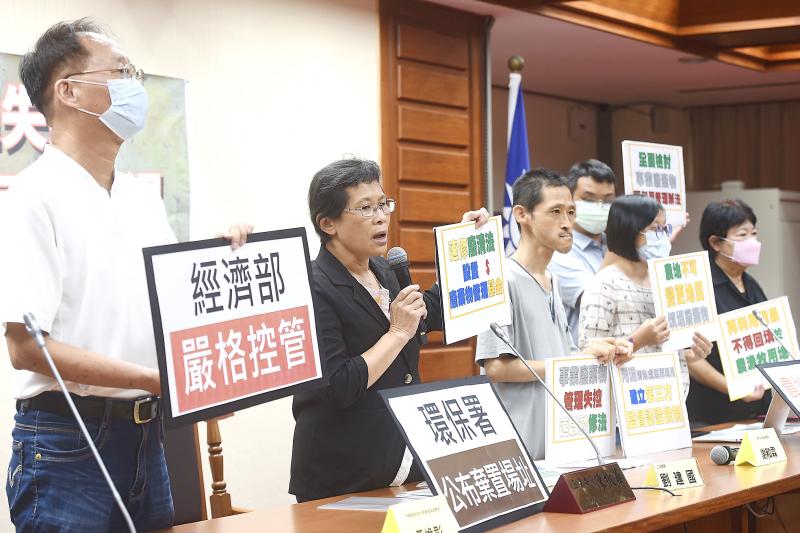
Photo: Chien Jung-fong, Taipei Times
Huang gave up the nation’s pretty scenery for its “colorful” waters — red for waste acid, milk-blue for strong alkali, reddish-purple for incinerator residue and emerald green for steel furnace slag.
The Erjen river is much cleaner now, Huang says, but he remains busy with countless other cases. He estimates that he’s exposed about 300 cases of wrongdoing so far — most notably the “dioxin duck” incident in 2009, when he found that thousands of animals were raised on a farm in Kaohsiung contaminated with slag from a steel furnace.
Huang rattles off a list of memorable “finds” from Taiwan’s north to south: illegally dumped alkaline soil in the Shimen Reservoir (石門水庫), hazardous incinerator residue at the mouth of the Dadu River (大肚溪), and excessive amounts of chromium in the rice paddies of Tainan’s Houbi District (後壁), to name a few.
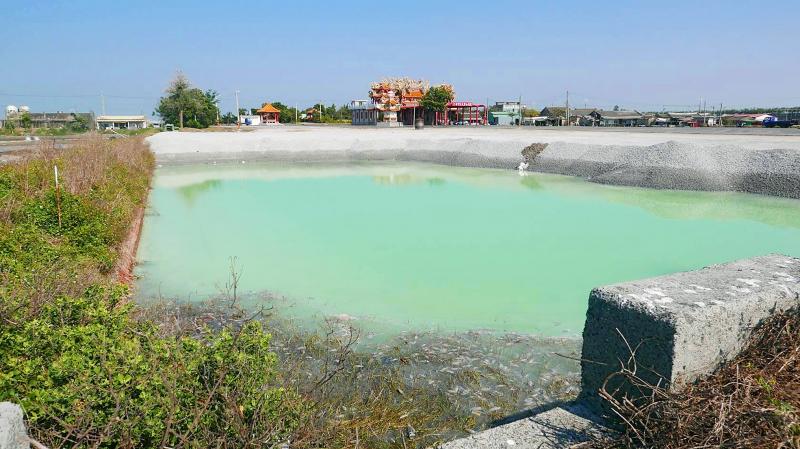
Photo courtesy of Huang Huan-chang
The Taiwan Alkali case is notable because Huang was able to find direct proof that the pollutants entered the food chain from the water and directly affected hundreds of factory workers and local residents, many of whom were suffering from tumors and cancer due to record breaking dioxin levels in their blood.
“I hope that Taiwan remembers this shameful record,” he says.
Huang says being persistent is key. The government initially denied wrongdoing, so in addition to presenting evidence and data, Huang held press conferences on a weekly basis, each one featuring a victim, until the authorities responded to their demands.
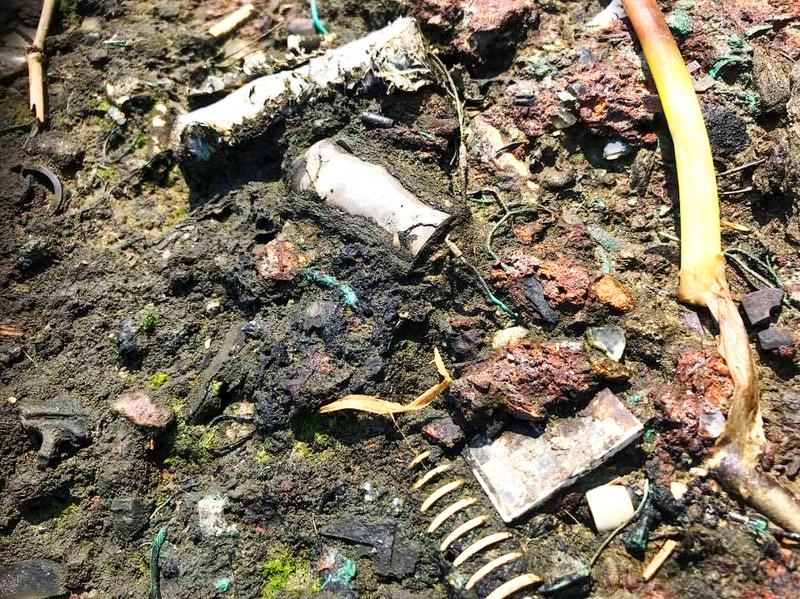
Photo courtesy of Huang Huan-chang
WASTE LOOPHOLES
Huang says it was better in the bad old days when the disposal of hazardous waste was more visible and its impact easier to assess. Today it is much worse. Waste is commonly scattered on farms and waters bodies, making it harder to detect.
Huang says the government’s broad designation of certain types of industrial waste as “reusable” in the name of sustainable development is problematic. Too often, these materials are not reused but mixed with soil and rocks and used to backfill farmland. Many gravel pits are actually fronts for carrying out these operations, Huang says.
More alarming is the hazardous waste that’s designated as reusable, Huang says. For example, printed circuit boards can be recyclable but only if treated properly. But too often, he adds, the circuits are often crudely crushed and filtered and then dumped into the land.
Loopholes in the legislation allows company owners, who illegally dispose of waste, to get away with small fines and little punishment. For example, those who dispose of waste deemed reusable are generally only fined NT$6,000, which is practically nothing when compared to their profits.
The company that was caught in 2015 dumping 400,000 tonnes of steel furnace slag in a field in Tainan’s Syuejia District (學甲), for example, was only fined NT$6,000 and ordered to clean it up. The government hit them with another NT$72,000 last year after finding more waste. The fine pales in comparison to the NT$200 million the company earned from its illegal dumping.
“We talk about a circular economy, but it’s circulating poison into the soil,” Huang says.
Waste disposal laws need to change for this to be fixed, Huang says, as the land is being polluted much faster than it’s being cleaned up. Also problematic is the soil sampling and testing methods, which often aren’t thorough or effective enough, he adds.
Aside from painstaking investigations and lobbying the government, Huang is spreading civic awareness through his environmental education classes at Tainan Community University, where students help with his documentation and restoration efforts.
Change is slow, Huang says, and the government still often denies his reports. But he will keep pushing.
“I just can’t let go of the land like this,” he says.

Anyone who has been to Alishan (阿里山) is familiar with the railroad there: one line comes up from Chiayi City past the sacred tree site, while another line goes up to the sunrise viewing platform at Zhushan (祝山). Of course, as a center of logging operations for over 60 years, Alishan did have more rail lines in the past. Are any of these still around? Are they easily accessible? Are they worth visiting? The answer to all three of these questions is emphatically: Yes! One of these lines ran from Alishan all the way up to the base of Jade Mountain. Its

The only geopolitical certainty is that massive change is coming. Three macro trends are only just starting to accelerate, forming a very disruptive background to an already unsettled future. One is that technological transformations exponentially more consequential and rapid than anything prior are in their infancy, and will play out like several simultaneous industrial revolutions. ROBOT REVOLUTION It is still early days, but impacts are starting to be felt. Just yesterday, this line appeared in an article: “To meet demands at Foxconn, factory planners are building physical AI-powered robotic factories with Omniverse and NVIDIA AI.” In other words, they used AI

Nov. 25 to Dec. 1 The Dutch had a choice: join the indigenous Siraya of Sinkan Village (in today’s Tainan) on a headhunting mission or risk losing them as believers. Missionaries George Candidus and Robert Junius relayed their request to the Dutch governor, emphasizing that if they aided the Sinkan, the news would spread and more local inhabitants would be willing to embrace Christianity. Led by Nicolaes Couckebacker, chief factor of the trading post in Formosa, the party set out in December 1630 south toward the Makatao village of Tampsui (by today’s Gaoping River in Pingtung County), whose warriors had taken the

The rhythms of bustling, working-class Mumbai are brought to vivid life in All We Imagine as Light. The stunning narrative debut of filmmaker Payal Kapadia explores the lives of three women in the city whose existence is mostly transit and work. Even that isn’t always enough to get by and pay the rent. One of the women, a widow, recently retired from working her whole life at a city hospital, Parvaty (Chhaya Kadam), is even facing eviction. The other two, roommates and co-workers in the maternity ward are in different parts of life. Prabha (Kani Kusruti) has a husband from an